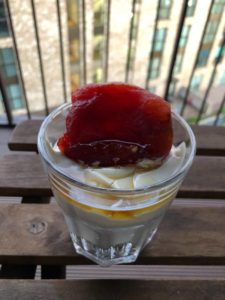Sweet v Savory Tomato & Feta Cheesecake
Hello & happy Cheesecake Day!
Since July 30 is the National Cheesecake Day in the US, I thought it’d be a great opportunity for an extra mid-week post to share a couple of cheesecake recipes.
I’d always thought of cheesecake as an American dessert. It was only recently that I learned that cheesecake (albeit not quite as we know it) may have been a popular dish in ancient Greece. In fact, Aegimus, a fellow Greek physician, wrote a book on the art of making cheesecakes – the earliest mention of cheesecake in (written) history. The earliest cheesecake recipes are found in ‘De Agri Cultura’, a book by the Roman historian Cato the Elder.
Nowadays, Greeks use cheese (such as the locally-produced feta, mizithra or katiki) in baking, but these bakes are savory rather than sweet.
To celebrate the Cheesecake Day and inspired by my Greek heritage and travels in Greece, I’m sharing two cheesecake recipes: one savory, the other sweet. The former is a brand new recipe, not published before; the latter is included in my e-book ‘Baking Therapy: Healthy Cakes & Bakes: Recipes Inspired By My Travels’, available for FREE for every new subscription (for a LIMITED TIME ONLY).
Savory tomato and feta cheesecake
The inspiration
As I’ve already mentioned, I’d always thought of cheesecake as a dessert, a wonderful way to finish off a meal, or even a stand-alone dessert. I’ve recently discovered that cheesecakes can be savory too, and they can be an interesting way to kick off a meal. Like sweet cheesecakes, they can be baked or not. Even though I love baking, when it comes to cheesecakes (savory or sweet), I prefer the no-bake recipes. Inspired by the fresh ingredients used in dakos, the refreshing Cretan salad, I recently came up with this brand new recipe for a savory tomato and feta cheesecake.
Ingredients:
For the base:
- 150 grams Cretan barley rusks (or other rusks)
- 150 grams butter, melted
- 1 teaspoon thyme
For the filling:
- 500 grams cream cheese
- 200 grams feta (or katiki or mizithra) cheese, crumbled
- 1 cup Greek yogurt (170 grams)
- Zest and juice of 1 lemon
For the topping:
- Cherry tomatoes, finely sliced (I used about 15)
- Balsamic cream or spray
Method:
- To prepare the base, beat the rusks in a blender until finely ground, then pour over the melted butter, and sprinkle the thyme.
- For the filling, mix the cream cheese, the crumbled feta cheese, the yogurt, the lemon juice and the lemon zest together (I do this by hand).
- Pour the mixture over the base, and refrigerate for at least several hours.
- Finally, pour the cherry tomatoes over the filling, drizzle with the balsamic cream (or spray with the balsamic spray), and place the cheesecake back in the fridge until it’s time to serve.

Tips:
To make and serve my cheesecake, I usually use a rectangular glass oven dish. This means that I don’t have to take the cheesecake out until it’s serving time, so I don’t have to worry about the cheesecake not holding its shape. If, however, you’re planning to use a springform pan and want your cheesecake to hold its shape when sliced, I would recommend using gelatine leaves (or sheet) in the recipe. Follow the product instructions; in general, you will need to hydrate the gelatine sheets in ice-cold water for a few minutes, then remove the hydrated gelatine and melt it in a pan at low temperature, before adding it to the cheesecake mixture and mixing well.
Sweet tomato and feta cheesecake
The inspiration
The inspiration for this cheesecake recipe came when I visited the island of Kos. Located just 4 miles away from the Turkish coast, this Greek island has a rich history that is often overlooked; this is where Hippocrates, the Father of Medicine, began his medical career. Built upon the slopes of a hill about a couple of miles northwest of Kos Town, the Asclepieion overlooks the Aegean with the Turkish coast on the background. Although it dates back to the fourth century BC, the ruins were only unearthed about a hundred years ago, at the beginning of the twentieth century.

Nowadays, Kos is a popular destination for European holiday-makers. But, the island has much more than its rich history and crystal-clear waters to offer. Another reason to visit Kos is for the local cuisine and delicacies: tomato spoon sweet, tomato jam and wine cheese. On my way back home, I had them all packed in my suitcase. Whilst unpacking, looking at these wonderful products, I came up with the idea for a sweet tomato cheesecake. It is a perfect way to showcase the tomato spoon sweet or the tomato jam. For the filling, however, I did not use wine cheese; instead, I used feta and cream cheese.

Spoon sweets
Spoon sweets are traditional desserts that can be made from most fruit, such as citrus fruits, cherries, figs, quinces, or even tomatoes (technically a fruit). In the past, fruits were preserved in sugar syrup to prolong their season, and this is how spoon sweets were born. Nowadays, they remain a popular dessert, usually served in a teaspoon on a small crystal or porcelain plate, along with a glass of water and/or coffee, as a welcome gesture. A spoon sweet is made with only one type of fruit, although you can also find spoon sweets made with nuts or roses (instead of fruit).
Ingredients:
For the base:
1. 100 grams digestive biscuits
2. 50 grams butter (or coconut butter), melted
3. 1 teaspoon cinnamon
For the filling:
1. 450 grams cream cheese (best to use full-fat)
2. 50 grams feta (or anthotyro) cheese, crumbled
3. 1 cup Greek yogurt (170 grams)
4. 1/4 cup honey (85 grams)
5. 1 teaspoon lime juice
6. 1 teaspoon vanilla extract
For the topping (optional):
I used tomato spoon sweet, but you can use any other spoon sweet, jam/marmalade, or fresh fruit, or even no topping at all (see tip below).
Makes 4 individual cheesecakes.
Method:
1. To prepare the base, crush or crumble the biscuits, then pour over the melted butter, and sprinkle the cinnamon. Divide the mix into 4 glass tumblers, and refrigerate them for about half an hour, before adding the filling on it.
2. For the filling, mix the cream cheese, the crumbled feta cheese, the honey, the yogurt, the lime juice and the vanilla extract together (I do this by hand).
3. Pour the mixture into the tumblers, over the base, and refrigerate them for at least several hours.
4. Finally, pour the topping over the filling (if using), and place the tumblers back in the fridge until it’s time to serve.

Tip:
Every time I want to showcase a spoon sweet (tomato or other), I prefer making individual cheesecakes, using this recipe. If, however, I’m planning to use jam/marmalade, I prefer making a regular-size cheesecake.
Further reading (and baking):
For more Greek cheesecake recipes, check out the following recipes by two of my favorite Greek chefs, Akis Petretzikis and Stelios Parliaros:
Savory cheesecake recipes:
Savory Cheesecake with Sweet Cherry Tomatoes (recipe by Akis Petretzikis)
Roasted cherry tomato and feta cheesecake (baked cheesecake recipe by Akis Petretzikis)
Sweet cheesecake recipes:
Greek cheesecake with citrus fruit (recipe by Stelios Parliaros, in Greek)
Greek cheesecake with figs (baked cheesecake recipe by Stelios Parliaros, in Greek)
Alex’s Great British Cheesecake
I think cheesecake is a great dessert to have on those long summer days, when you want something else than ice-cream or gelato and yet you crave an equally refreshing dessert to finish off your meal. In the summer of 2012, when London hosted the 30th Summer Olympics and Queen Elizabeth II celebrated her Diamond Jubilee (marking the 60th anniversary of her accession to the throne), I became rather obsessed with anything that had the Union Jack on; unsurprisingly my cheesecake recipe suffered the same fate and soon paired with the iconic United Kingdom flag. To make it a bit less Greek and more British, I am not using feta cheese for the filling, and instead of topping it with spoon sweet, I top it with fresh berries. And this is how the Great British Cheesecake was born.
The recipe for my Great British Cheesecake is included in my e-book ‘Baking Therapy: Healthy Cakes & Bakes: Recipes Inspired By My Travels’, available for FREE for every new subscription (for a LIMITED TIME ONLY).

To give you an idea about other recipes included in my e-book, check out my post ‘Healthy cakes & bakes inspired by my travels‘.
Last but not least, check out my upcoming post ‘There’s more to Greek cheeses than feta’, due to be published on 1 August.
Bon Appétit!
Alex
(the soon-to-be-Traveling-again-Psychiatrist)
One Comment
Pingback: